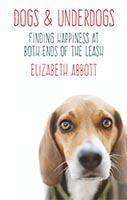Why Fido is our BFF: Book review
Rescue dogs can bring out the humanity in all of us, which is why they’re used for therapeutic purposes with prison inmates
This Dec. 25, 2014 photo provided by Emily Amsler via the Oregon Humane Society shows Dr. Amy Amsler, Oregon Humane Society volunteer during a rescue of Sandy a yellow Labrador who got spooked on a Christmas Day hike in the Columbia Gorge. Sandy snapped her leash and plunged 150 feet down a cliff before being rescued in the dark by climbers who rappelled to a narrow ledge where the animal was trapped. The Oregon Humane Society said the dog suffered only minor injuries. (AP Photo/ Emily Amsler via Oregon Humane Society)
Share
Dogs and underdogs: finding happiness at both ends of the leash
Elizabeth Abbott
Best-known for her popular histories of human relationships (A History of Mistresses, A History of Marriage) and objects (Sugar: A Bittersweet History), Abbott, a Canadian academic and author, departs from form with this book. An account of her volunteer efforts to rescue unwanted and abused dogs, it begins in Haiti, where she was a reporter for Reuters during the Duvalier era and where she left behind her beloved dog, Tommy, and ends in her Toronto home, “a way station for needy dogs.” In between trot a large cast of canine characters, with Bonzi the beagle as the main plot device.
From his rescue in rural Ohio to his stint at a dog-training program in an American prison and, finally, his adoption by the author, Bonzi personifies Abbott’s mantra that redemption does not discriminate. Through his and other dogs’ inspiring stories, Abbott gets at the highs and lows of loving an animal we will inevitably outlive: the therapeutic balm of physical contact, the way a damaged rescue dog can become both our “albatross and purpose,” and the acute grief when a beast who loved us unconditionally finally dies.
“Inside prison, hatred and vitriol are in the air that you breathe; initiative and self-esteem are frowned on,” writes Shane Livingston, an imprisoned dog trainer who has since been released. “But when you get a dog and become a trainer, you are forced to reclaim your initiative, and sense of self-worth with it . . . You learn to let go of anger, to try to be better.”
When the words of her subjects pack such a visceral punch, Abbott’s uncharacteristic lapses into sentimentality—she recreates dialogue at a humane society, for one—seem clumsy and unnecessary. But her profound emotional connection to this subject distinguishes it from her other biographies. She believes all dogs, no matter how ill or injured, need saving, and that we humans owe it to them to “trade with the gifts God gave us.” In her single-minded commitment to the cause, some readers may see zeal bordering on fanaticism. But she did indeed find happiness at both ends of the leash. And as someone whose adopted rescue dog also brought her joy (and eventual heartbreak), this reader is deeply grateful to her and others like her.
